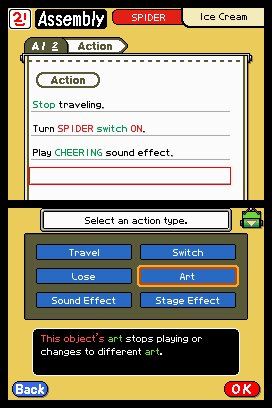The original premise behind the WarioWare games was that the titular Wario wanted to capitalize on his greed by making a bunch of hastily assembled microgames to cash in on videogaming. While it sounds like a recipe for another horrid party game, it was actually great. There were a lot of five- to 15-second microgames, and most were really very fun. The game’s quirky style and ADD pacing only helped the bizarre stream-of-consciousness nature of the microgames, which ranged from picking hairs out of a nose to cooking a piece of meat on a spit amongst many others.

WarioWare D.I.Y for DS takes this concept and breaks it down to its bare essentials, giving gamers a full selection of premade microgames, but putting the focus on creativity and enabling players to make their own microgames. WarioWare has always had a ramshackle feel that made it unique, and the microgames always felt like they were made from random doodles and art assets the team had lying around. This visual style lends itself extremely well to D.I.Y’s concept, as even the most half-assed user creation will match the game’s visuals perfectly. There’s no shortage of pre-made stuff to use, either, including WarioWare-style art, as well as original sprites from NES games. Want to make a game where you fling little Donkey Kongs into a poorly drawn nose? Go nuts.
The most essential part of a do-it-yourself game like this is providing an easy-to-use interface that makes getting the player’s ideas into the game as simple as possible. With that in mind, WarioWare D.I.Y uses a straightforward system to designate the different parts of a microgame: Background, Objects, Assembly and Setting. Players create the background of a level by drawing with the game’s fill tools, brushes and premade stamps. This can be as easy as drawing a line across the middle of the screen and using green paint for the bottom and the “starry night” paint for the top. Stamp some Easter Island stone heads in there, and you’re set.

From there, you designate which objects will be moving and interacting, and what the parameters are for success with a command-line interface. This interface works with a simple mixture of verbs and objects, though if you’ve ever played a text-only adventure game with commands like GO SOUTH, USE KEY, and THROW BABY, you’ll definitely have a leg up. You’re also incredibly old.
The game doesn’t just pitch you into the creator unprepared though, there’s also a challenge mode that presents you with semi-completed games that you need to finish. The challenges help teach you how to use the game’s command-line system via fill-in-the-blank type questions that require you to noodle out what object Ashould do when it touches object B.
WarioWare D.I.Y will also arrive as a WiiWare title, WarioWare D.I.Y Showcase. Strangely, Showcase doesn’t include the DS version’s ability to create new microgames. The WiiWare version includes a bunch of finished, playable microgames, however, as well as the ability to play microgames created on the DS via Wi-Fi transfer. The real draw for those who get both versions is that the assets from the minigames exclusive to Showcase can be transferred to the DS version. Showcase also includes WarioWare character 9-Volt’s classic, Nintendo-based microgames, including sprites from Kid Icarus and what looked like the original Famicom Wars (the franchise that became the Advance Wars series).

While the WarioWare franchise has never been afraid to jump into new or strange control schemes, (WarioWare Twisted! used an accelerometer in the cartridge to incorporate tilt based play on the GBA, for example), D.I.Y has to keep it much simpler. To keep the games compatible between the Wii and DS, the gameplay functions have been reduced to a point-and-click-style interface; no dragging, blowing, or camera interaction allowed. This is something of a letdown, though probably necessary to keep the game-making aspect simple enough for average gamers to comprehend. Even so, we have to question whether sacrificing the control options was worth it for Wii functionality; the appeal of playing a portable game on the big screen is minimal.
We didn’t get to try out the music generator program, but it looks as though anyone who’s ever fiddled with the music making program in Mario Paint will feel at home. Drag and drop icons allow for easy cutting and pasting of sounds and melodies, and like the game’s other content, you can modify preexisting songs. The game also sports the ability to convert your own terrible humming into an actual tune to give your microgames even more personality.

Games like LittleBigPlanet, Scribblenauts, and even the custom maps of PC FPSes have encouraged gamers to take things into their own hands and explore the game mechanics to see if they can outdo the developers. D.I.Y looks like it’ll give gamers everything they need to put together bizarre microgames - but as is the case with every user generated content game, you can expect the reward to be directly proportional to how much time you invest in it. Although the novelty of a crudely drawn wiener zooming into a pair of boobs will surely never fade.
Mar 4, 2010

